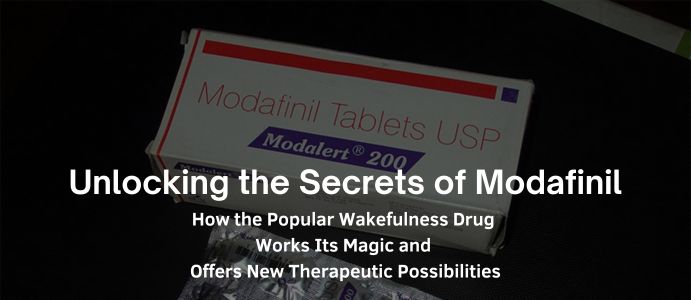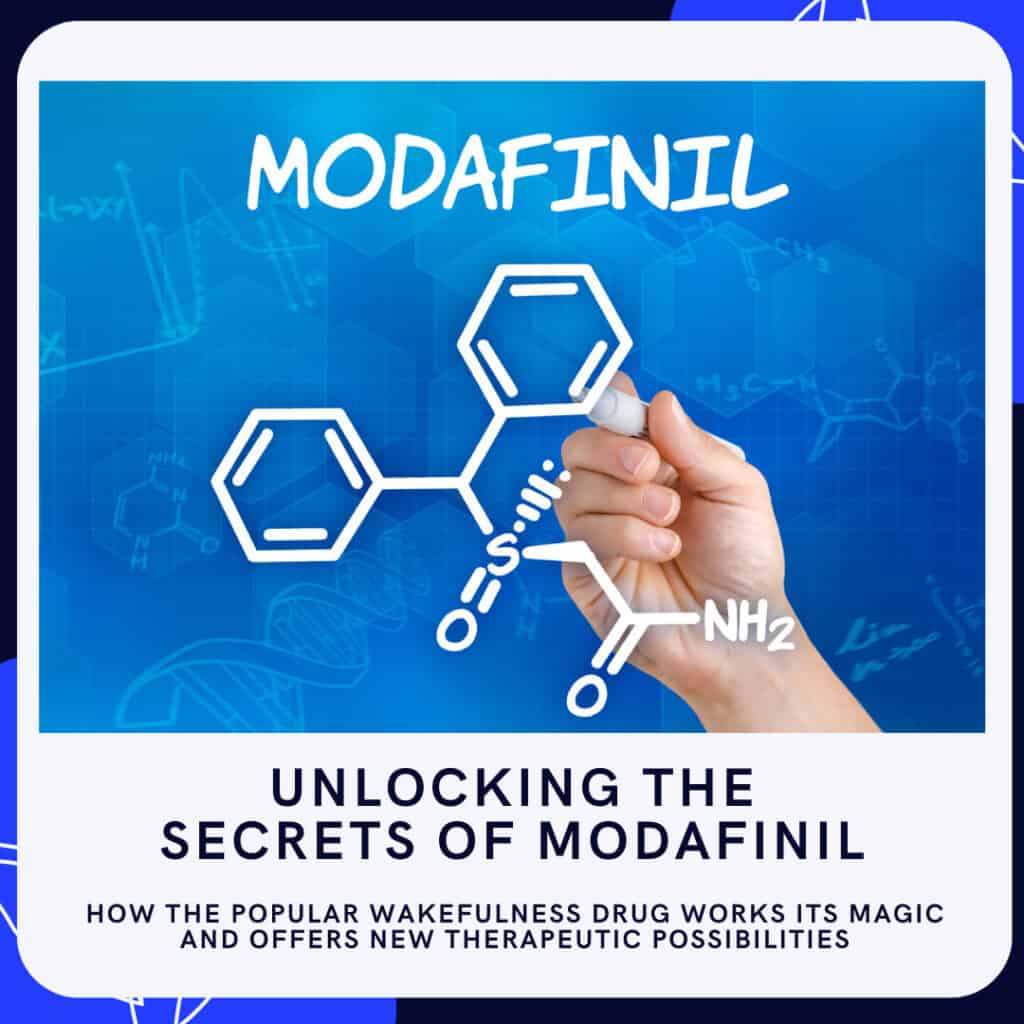

The Enigma of Modafinil’s Wake-Promoting Mechanism
Have you ever wondered how modafinil, a popular drug used to promote wakefulness, actually works? Even though it’s widely used, the exact mechanism behind its wake-promoting effect has remained a mystery. The study entitled “Effect of the Wake-Promoting Agent Modafinil on Sleep-Promoting Neurons from the Ventrolateral Preoptic Nucleus: an In Vitro Pharmacologic Study” by Thierry Gallopin, Luppi Pierre-Hervé, Francis Rambert, Armand Frydman, and Patrice Fort, published in SLEEP in 2004[1]Gallopin, T., Pierre-Hervé, L., Rambert, F., Frydman, A., & Fort, P. (2004). Effect of the Wake-Promoting Agent Modafinil on Sleep-Promoting Neurons from the Ventrolateral Preoptic Nucleus: an In Vitro Pharmacologic Study. Sleep, 27(1), 19-25., decided to explore this puzzle by focusing on modafinil’s interactions with sleep-promoting neurons in the brain.
The Crucial Role of the Ventrolateral Preoptic Nucleus (VLPO)

Researchers were particularly interested in a region called the ventrolateral preoptic nucleus (VLPO), which plays a significant role in sleep regulation. They studied brain slices from rats to understand modafinil’s impact on sleep-promoting neurons in the VLPO. Specifically, they examined how the drug influences noradrenaline-induced inhibition and the noradrenaline transporter (NAT).
Modafinil’s Unique Interaction with Noradrenaline
Their experiments led to some fascinating discoveries. Modafinil was found to enhance the inhibition of sleep-promoting neurons by noradrenaline, a neurotransmitter involved in alertness and arousal. Interestingly, this enhancement was specific to noradrenaline and not observed with other major arousal neurotransmitters like dopamine or serotonin. In other words, modafinil has a unique interaction with noradrenaline, increasing both the duration and strength of its inhibitory effects on VLPO neurons.
Investigating the Role of the Noradrenaline Transporter (NAT)
To figure out the underlying mechanism, researchers investigated the role of the noradrenaline transporter (NAT), a protein responsible for the uptake and recycling of noradrenaline in the brain. While modafinil didn’t directly bind to the NAT, it somehow managed to enhance the inhibitory effects of noradrenaline. This led the researchers to hypothesize that modafinil might be affecting processes related to noradrenaline uptake or packaging. When they tested a selective NAT inhibitor called nisoxetine, they found that it produced similar effects to modafinil, further supporting their hypothesis that modafinil’s action is linked to the noradrenergic system.
How Modafinil Reinforces Wakefulness
These findings support the idea that modafinil’s wake-promoting effect is partly due to enhancing noradrenaline inhibition in sleep-promoting neurons. When we’re awake, various wake-active neurons inhibit the VLPO sleep-promoting neurons. As the inhibitory inputs gradually decrease, sleep-promoting neurons become active and initiate sleep. Modafinil seems to reinforce noradrenaline inhibition, effectively preventing the onset of sleep by maintaining control over these neurons.
Potential Antidepressant Effects of Modafinil

The study also uncovered a connection between modafinil and potential antidepressant effects. Since NAT is targeted by many classic antidepressant drugs, the observed interaction between modafinil and NAT could point to the drug’s potential as a novel antidepressant. This connection warrants further investigation to explore modafinil’s full therapeutic potential.
Limitations and Future Directions

However, it’s important to consider the study’s limitations. The experiments were performed on brain slices, which may not fully represent the in vivo effects of modafinil on wakefulness. Moreover, the concentrations of modafinil used in the study might be higher than those needed to induce waking in rats. Future research should explore these aspects using animal models and investigate modafinil’s effects on other neurotransmitter systems.
Demystifying Modafinil and Uncovering Its Therapeutic Potential
In conclusion, this study offers compelling evidence that modafinil’s wake-promoting effect involves enhancing noradrenaline inhibition on sleep-promoting neurons in the VLPO through interactions with the NAT. These findings contribute to our understanding of modafinil’s unique mechanism of action and open doors for future research, which could unveil new ways to harness its therapeutic potential. Not only could modafinil be further developed for promoting wakefulness in people with sleep disorders, but it might also hold promise as a treatment for depression.
Distinguishing Modafinil from Other Stimulants and Arousal-Promoting Drugs
By unravelling the mystery of Modafinil’s wake-promoting mechanism, this study has provided crucial insights into how the drug specifically interacts with the noradrenergic system. These findings help explain modafinil’s unique pharmacological profile, distinguishing it from other stimulants and arousal-promoting drugs.
The Ongoing Journey to Understand Modafinil’s Full Potential
However, the journey of understanding Modafinil’s full potential is far from over. As researchers continue to explore its effects on other neurotransmitter systems and validate the results in animal models, we can look forward to a better understanding of modafinil’s place in the world of pharmacology. Not only will this help improve our knowledge of the drug’s mechanism of action, but it could also pave the way for new and innovative therapeutic applications, potentially improving the lives of people with sleep disorders, depression, or other conditions where enhanced wakefulness and mood regulation are needed.
Summary: The Significance of this Study and its Impact on Future Research
This study has taken a significant step forward in demystifying the mechanism behind modafinil’s wake-promoting effect, revealing the critical role of noradrenaline inhibition on sleep-promoting neurons in the VLPO and its interaction with the NAT. As we continue to delve deeper into the intricacies of modafinil’s action, the future holds exciting possibilities for further advancements in our understanding and utilization of this remarkable drug.
Exploring New Therapeutic Applications for Modafinil
Unravelling the secrets of modafinil has not only helped us understand its wake-promoting effects but also opened up new avenues of research that could lead to novel therapeutic applications. By continuing to explore the fascinating world of modafinil, researchers are laying the groundwork for better treatments for sleep disorders, depression, and other conditions where enhanced wakefulness and mood regulation could make a difference in people’s lives. As our knowledge of modafinil grows, so too does the potential for its use in a variety of medical and therapeutic contexts.
Buy Modafinil Online Review Comparison Table
| Product | Company | Quantity | Price | Country | Website |
 Modalert, Modvigil | ModafinilXL | 10 - 500 pills (100 & 200mg) | $29 - $599 |  AU, USA, Worldwide | Visit Website >> |
References
| ↑1 | Gallopin, T., Pierre-Hervé, L., Rambert, F., Frydman, A., & Fort, P. (2004). Effect of the Wake-Promoting Agent Modafinil on Sleep-Promoting Neurons from the Ventrolateral Preoptic Nucleus: an In Vitro Pharmacologic Study. Sleep, 27(1), 19-25. |
|---|

Leave a Reply